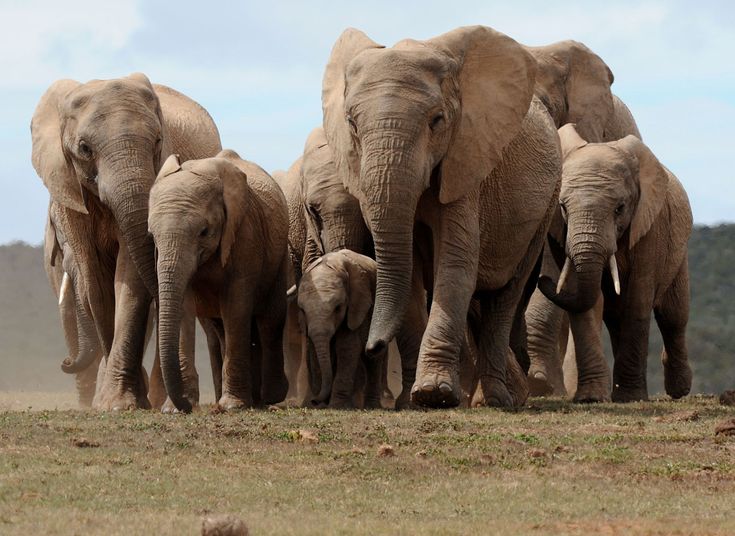Forest Elephants in Bwindi
Forest Elephants in Bwindi. Bwindi Impenetrable National Park in southwestern Uganda is globally famous for its mountain gorillas, but few visitors know about another unique resident: the elusive forest elephant (Loxodonta cyclotis). These elephants, which differ in several ways from their savanna cousins, add remarkable biodiversity to Bwindi’s ancient forest ecosystem.
This article explores the unique characteristics, behaviors, ecological role, and conservation status of forest elephants in Bwindi, providing tips for those who hope to spot these majestic animals during their visit.
1. What Are Forest Elephants?
Forest elephants are a distinct species of African elephant. Here’s what sets them apart:
- Smaller Size: Forest elephants are generally smaller than savanna elephants, with adult males reaching up to 8 feet tall, compared to savanna males, which can grow over 10 feet.
- Unique Physical Traits: They have straighter, downward-facing tusks, which help them move easily through dense forest undergrowth. Their ears are also more rounded than those of savanna elephants, aiding their navigation in forest environments.
In Uganda, forest elephants are rare and difficult to spot due to their shy behavior and the dense foliage of Bwindi Impenetrable National Park.
2. The Role of Forest Elephants in Bwindi’s Ecosystem
Forest elephants are often called “forest engineers” because of the vital role they play in shaping their environment. Here’s how they benefit Bwindi’s ecosystem:
- Creating Forest Clearings: As they roam, forest elephants naturally clear patches of vegetation, allowing sunlight to penetrate the canopy. These clearings create new habitats for other plants and animals, boosting overall biodiversity.
- Seed Dispersal: Forest elephants consume a wide variety of fruits and spread seeds across long distances through their dung. This process helps maintain plant diversity and promotes forest regeneration.
- Soil Enrichment: Elephant dung enriches the soil, providing essential nutrients for plants and fungi in Bwindi’s ecosystem.
By helping to maintain the health and diversity of Bwindi’s ecosystem, forest elephants indirectly support a wide array of species, including birds, insects, and even the famous mountain gorillas.
3. Why Forest Elephants Are Hard to Spot in Bwindi
While forest elephants are present in Bwindi, they are rarely seen by visitors. Here’s why:
- Dense Forest Habitat: Bwindi is one of Africa’s densest forests, with thick undergrowth and a dense canopy, which makes it challenging to spot large animals from a distance.
- Elusive Behavior: Forest elephants are more reclusive than their savanna relatives, often preferring quieter areas and moving in small groups to stay under the radar.
- Nocturnal Activity: Forest elephants are more active during the night or early morning hours, avoiding peak tourist hours. Visitors often find signs of their presence—like footprints, dung, or broken branches—rather than seeing the animals themselves.
For wildlife enthusiasts, spotting forest elephants in Bwindi is a rare experience, often requiring patience, a trained guide, and a bit of luck.
4. Conservation of Bwindi’s Forest Elephants
Forest elephants face numerous threats across Africa, and those in Bwindi are no exception. Here’s what you need to know about their conservation status:
- Threats to Forest Elephants: These elephants are endangered due to habitat loss, poaching, and human-wildlife conflict. The demand for ivory has historically made them targets for poachers, while expanding human settlements around Bwindi’s borders continue to threaten their natural habitat.
- Protected Habitat in Bwindi: Bwindi Impenetrable National Park is a UNESCO World Heritage site, offering legal protection to forest elephants within its borders. Uganda Wildlife Authority (UWA) conducts regular patrols to monitor and protect these elephants.
- Conservation Programs: Several conservation organizations partner with UWA to track forest elephant populations and develop strategies for coexistence with local communities, as well as provide education on the importance of forest elephants to the ecosystem.
Through these conservation efforts, Bwindi’s forest elephants receive a level of protection, but continued efforts are necessary to ensure their survival.
5. How to Maximize Your Chances of Spotting Forest Elephants in Bwindi
While spotting forest elephants is not guaranteed, here are a few tips that might increase your chances:
- Visit Known Elephant Trails: Local guides can take you to areas where forest elephants are known to travel, although sightings remain rare due to the elephants’ elusive nature.
- Early Morning Excursions: Forest elephants are more active at dawn and dusk. Planning early morning excursions might improve your chances of seeing them or, at the very least, spotting fresh signs of their activity.
- Look for Signs, Not Just Sightings: Since direct sightings are challenging, focus on identifying signs of elephants. Guides can help you spot footprints, dung, or broken branches that indicate recent elephant activity.
These forest elephants are more of a “bonus” wildlife experience for visitors, as Bwindi’s main draw remains its gorilla trekking opportunities.
6. Why Forest Elephants Matter in Bwindi’s Tourism and Conservation
Although gorillas are Bwindi’s primary attraction, forest elephants add another layer of appeal to the park’s rich biodiversity. Here’s why they matter:
- Enhancing Biodiversity: Forest elephants contribute to Bwindi’s ecological richness, supporting a broader array of plants and animals that appeal to eco-conscious travelers.
- Inspiring Conservation: The more diverse Bwindi’s animal population, the more attention it receives for conservation, benefiting all species in the park.
- Educational Opportunities: For tourists and researchers alike, learning about Bwindi’s elephants broadens the understanding of forest ecosystems and the interconnectedness of species.
As the hidden giants of Bwindi, forest elephants are an integral part of Uganda’s natural heritage, contributing to both the ecosystem’s health and its allure as a premier wildlife destination.
Conclusion
While they might be difficult to spot, the forest elephants of Bwindi Impenetrable National Park play an essential role in shaping this ancient forest. From seed dispersal to creating forest clearings, these elephants maintain the health and diversity of Bwindi’s unique ecosystem. Although elusive, their presence adds a special element to the experience of visiting Bwindi, especially for those who appreciate the park’s diverse wildlife beyond its famous mountain gorillas.
So, when you visit Bwindi, keep an eye out for the signs of these majestic animals, and remember that even if you don’t see them directly, forest elephants are quietly shaping the forest around you, ensuring that Uganda’s “Pearl of Africa” remains vibrant for generations to come.




